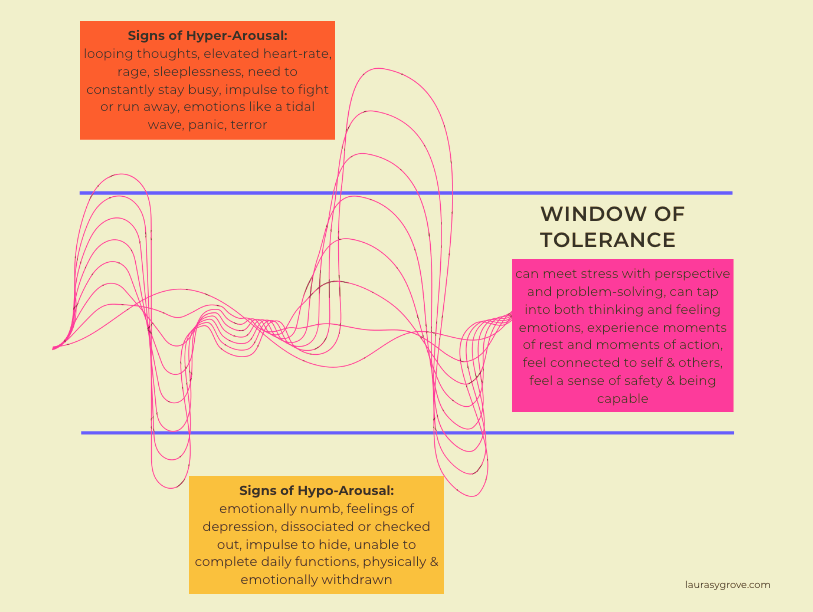Exploring your window of tolerance
“Window of tolerance” is something you’re likely to hear lots of therapists reference over the course of our time with clients. First coined by Dr. Dan Siegel, the concept refers to an optimal state of nervous system arousal, which you can just think of as the zone we’re functioning in when we feel like things are generally manageable in our lives.
When I introduce this to people, one of the first things I like to clarify is that being within our window doesn’t mean that we’re always calm. Instead, it can be thought of as a state where we experience flexibility; we encounter stressors that we feel we can deal with in effective ways, and maintain the ability to - as Janina Fisher says - tap into both the thinking and feeling parts of our brains (versus being overcome by or unable to access one or the other).
I think of the window of tolerance as being characterized by qualities and capacities like: regulation, flow, creativity, learning, growth, and moments of stress that are followed by low or no stress (aka periods of recovery). There are absolutely ups and downs in this zone (because… life!), but we feel equipped to ride those waves.
When we’re outside our window of tolerance, we’re in a state of overwhelm of some kind. Overwhelm manifests in two general ways: as over-arousal (which is called hyperarousal) or under-arousal (hypoarousal). Simply put, we either get very activated or we shut down. We’re all going to find ourselves in a degree of hyper- or hypoarousal from time to time, and for people living with chronic stress and the impacts of trauma, we may be so accustomed to living in states of overwhelm, they’ve become the norm or default.
I often hear people describe a window of tolerance as having gotten smaller when we find ourselves in hyper- or hypoarousal, and while this framing makes a lot of sense, in many instances I find myself thinking of it more like there may be so much going on inside and outside of us that we’re being pushed beyond the boundaries of our window, or crowded out of our window. In other words, it’s not that we’re unable to carry or tolerate much, it’s actually more likely that we’re carrying too much (and, in the case of chronic stress and trauma, have been for a very long time).
Window of Tolerance as a Tool
Gaining some insight into your unique window of tolerance can be a really useful tool for creating increased awareness about the signs and signals of approaching, or being in, a state of overwhelm. With this greater awareness, we can develop ways to intervene when we notice we’re nearing the outer limits of our window, as well as develop practices to acknowledge, soothe, and recover back into our windows when we’re experiencing over- or under-activation.
In the diagram I re-created of Dan Seigel’s concept below, you’ll see some examples of thoughts, feelings and behaviours that tend to be associated with each state. (You could think of this as what are you doing, saying, thinking, sensing and feeling when you’re in each of these areas?) This is certainly not an exhaustive list, but will give a sense of how overwhelm might show up and also how we might be functioning when inside the window.
The work we do in therapy around window of tolerance typically involves:
exploring the unique ways you experience overwhelm, including what shows up in your thoughts, emotions, physical sensations and behaviours that signal you’re in each zone,
getting curious about how you’re currently attempting to regulate or stay within your window and collaboratively assessing how those attempts are working or not presently,
and - while holding a lot of respect for how current and historical strategies have served you - experimenting with and practicing preferred methods that support you to spend more time in your window of tolerance and return to the window when you’ve been pushed outside.
